The dynamic nature of the business environment necessitates strategic planning and analysis tools capable of evaluating an organization's internal and external factors. One such invaluable tool is SWOT Analysis, which evaluates the Strengths, Weaknesses, Opportunities, and Threats of an organization. In this article, we'll take a detailed look at the concept, history, and components of SWOT Analysis.
An Overview of SWOT Analysis
SWOT Analysis, an acronym derived from Strengths, Weaknesses, Opportunities, and Threats, is a strategic planning tool used to identify and analyze these four elements of an organization. By mapping these elements, companies can develop strategies that capitalize on their strengths and opportunities while mitigating weaknesses and threats.

The concept of SWOT Analysis dates back to the 1960s and is often credited to Albert Humphrey. Humphrey led a research project at Stanford University involving Fortune 500 companies, where he aimed to understand why corporate planning failed. The research led to the development of the SOFT Analysis (Satisfactory, Opportunity, Fault, Threat). Later, the SOFT Analysis was tweaked into what we now know as SWOT Analysis.
Despite its age, the SWOT Analysis tool remains relevant in today's dynamic business environment. Its versatility makes it applicable across diverse sectors and organizations of various sizes, aiding strategic decision-making.
Deep Dive into Four Components of SWOT Analysis
Now, let's delve deeper into each component of the SWOT Analysis.
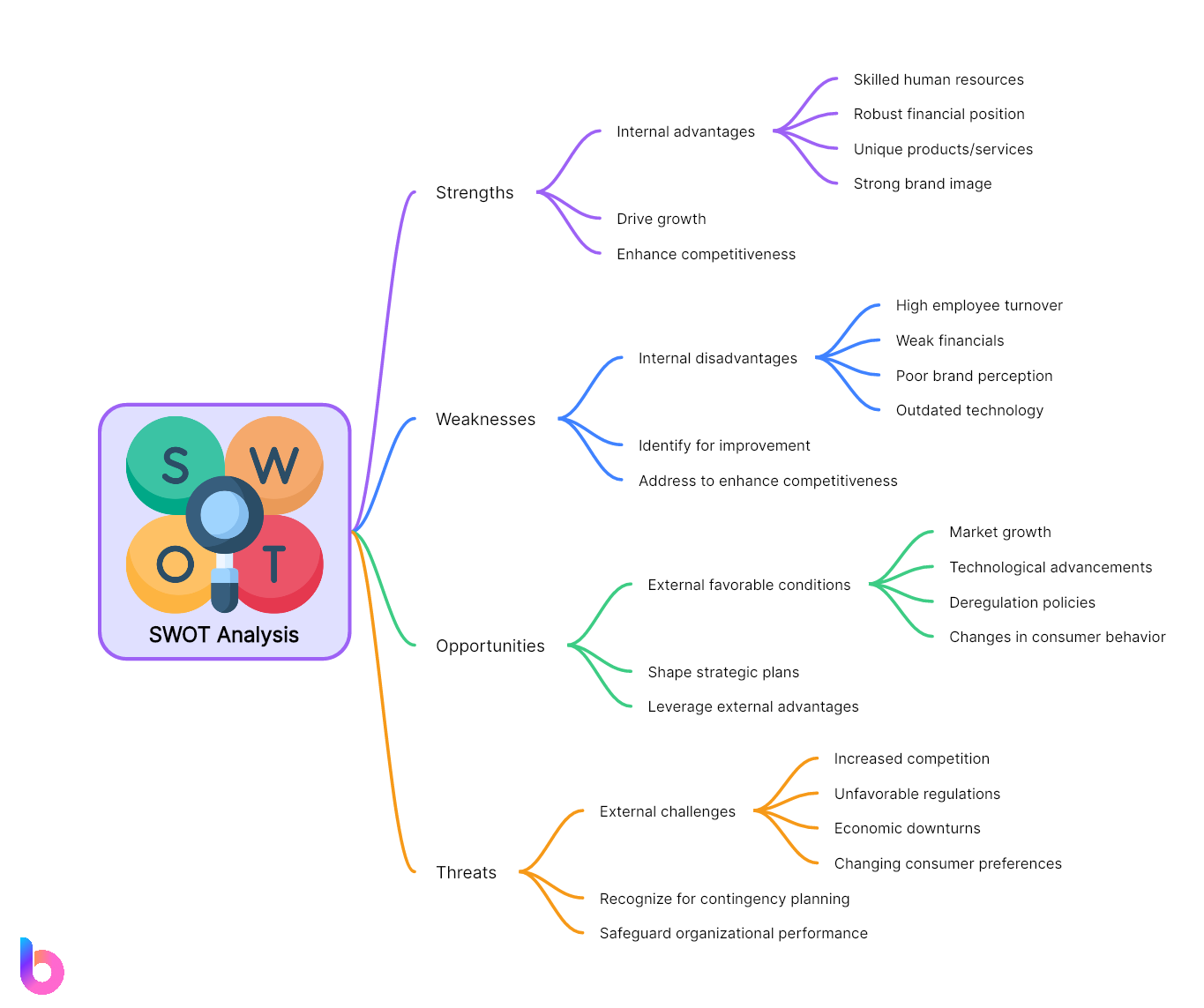
Strengths: These are internal factors that give an organization an advantage over its competitors. Strengths could include skilled human resources, robust financial position, unique products or services, a strong brand image, etc. Identifying and utilizing these strengths can drive a company's growth and competitiveness.
Weaknesses: Contrary to strengths, weaknesses are internal factors that put an organization at a disadvantage relative to competitors. This could be high employee turnover, weak financials, poor brand perception, or outdated technology. Identifying weaknesses helps organizations work on these areas to improve their competitive position.
Opportunities: These are external factors in the environment that an organization could potentially leverage to its advantage. It could be market growth, technological advancements, deregulation policies, or changes in consumer behavior. Recognizing these opportunities can help shape strategic plans that exploit these favourable conditions.
Threats: Lastly, threats are external factors that could hinder an organization's performance. It could be increased competition, unfavorable government regulations, economic downturns or changing consumer preferences. Recognizing potential threats allows for contingency planning to safeguard the organization.
SWOT Analysis is an essential strategic planning tool that provides a comprehensive picture of an organization's internal strengths and weaknesses and external opportunities and threats. Its ability to provide such insights makes it instrumental in shaping successful organizational strategies.
Why SWOT Analysis Is Crucial in All Walks of Life
Though commonly used in business scenarios, the application of SWOT Analysis extends far beyond that realm. In essence, it's a versatile tool that allows for a thorough examination of both positive and negative factors in any given situation. Here's why SWOT Analysis proves crucial in various walks of life.
In personal development, SWOT Analysis can assist individuals in identifying their personal strengths and weaknesses. Recognizing personal opportunities and potential threats can provide clarity on how to approach career progression, personal growth, or even lifestyle changes.
In educational settings, both educators and students can use SWOT Analysis. Teachers can use it to assess their teaching methods or classroom environment, while students can use it to analyze their academic strengths and areas needing improvement.
In the public sector, SWOT Analysis can aid government agencies in evaluating the efficiency of their programs and initiatives. It helps identify areas that need improvement and those that offer room for expansion.
Non-profit organizations can leverage SWOT Analysis to assess their programs, identify new fundraising opportunities, and recognize potential risks that may impact their mission.
Clearly, the versatility of SWOT Analysis makes it applicable and beneficial in diverse scenarios, highlighting its importance in different aspects of life.
When and Where to Use SWOT Analysis
Given its utility, SWOT Analysis can be used in numerous scenarios across different sectors. Here are some typical situations where it's applied:
- Business Strategy Planning: Companies often employ SWOT Analysis during strategic planning to identify their competitive advantages and recognize market opportunities.
- Product Launch: Before launching a new product or service, companies may perform a SWOT analysis to identify potential threats or weaknesses that could impact the product's success.
- Career Planning: Individuals may use SWOT Analysis when planning their career progression to understand their strengths better, identify areas for improvement, recognize opportunities for growth and be aware of potential threats to their career advancement.
- Marketing Plans: Marketers often use SWOT Analysis to strategize effective marketing campaigns by recognizing the company's strengths, understanding the weaknesses, capitalizing on opportunities, and preparing for possible threats.
- Organizational Change Management: When planning significant organizational changes like mergers, acquisitions or restructuring, companies often use SWOT Analysis to understand how these changes may affect their business dynamics.
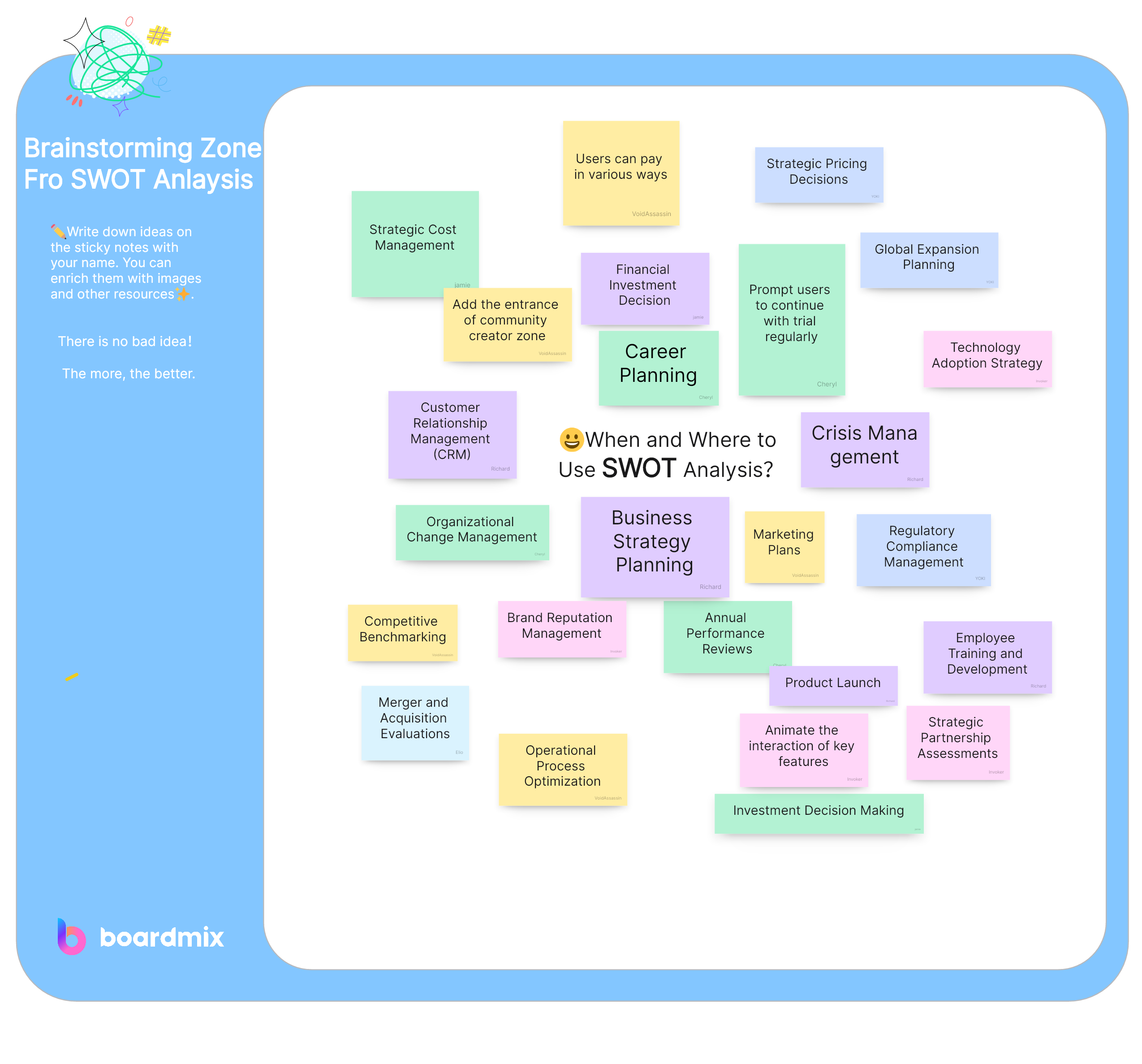
SWOT Analysis is an extremely adaptable tool that can be employed in various scenarios across multiple sectors. Whether it's strategic business planning, personal development, or educational applications, it offers invaluable insights that can guide decision-making and planning processes.
Steps to Conduct a Thorough SWOT Analysis
When it comes to strategic planning and decision making, the SWOT Analysis stands out as an effective and straightforward tool. A comprehensive SWOT Analysis can identify an organization's strengths, weaknesses, opportunities, and threats, providing essential insights for strategic planning.
This part will guide you through the steps to conduct a thorough SWOT Analysis using Boardmix, a collaborative decision-making tool that brings your team’s ideas together in one place.
What Is Boardmix
Boardmix is a comprehensive SWOT analysis tool designed to provide users with a systematic approach to evaluating Strengths, Weaknesses, Opportunities, and Threats related to a particular project, business, or initiative. The software offers several key features that contribute to its effectiveness in strategic planning:
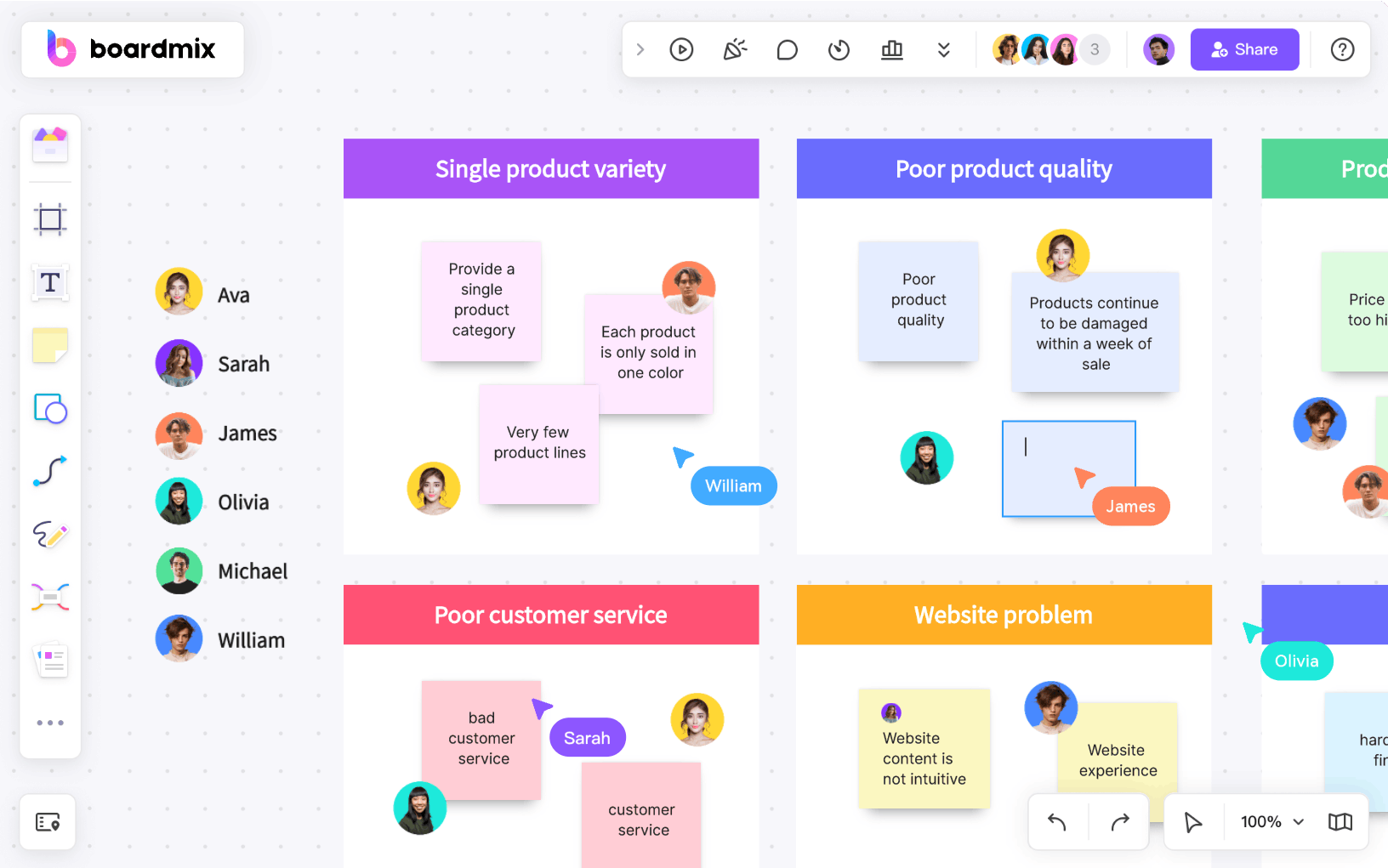
- User-Friendly Interface: Boardmix boasts an intuitive and user-friendly interface, making it accessible to both experienced strategists and those new to SWOT analysis.
- Collaborative Capabilities: The tool facilitates collaboration among team members, allowing them to contribute to the SWOT analysis process in real-time. This feature enhances communication and ensures that diverse perspectives are considered.
- Data Visualization: Boardmix utilizes effective data visualization techniques, such as charts and graphs, to present the SWOT analysis results in a clear and easily understandable format. This aids decision-makers in interpreting complex information more efficiently.
- Customization Options: Users can tailor their SWOT analysis based on the specific needs and goals of their project or business. This flexibility enables a more targeted and relevant evaluation.
- Integration with Other Tools: Boardmix may offer integration capabilities with other project management or collaboration tools, streamlining workflows and enhancing overall productivity.
Here is how to conduct a SWOT analysis using Boardmix.
Step 1: Define the Objective
Before you start your SWOT Analysis using Boardmix, clearly define the objective. Whether it's understanding the potential of a new project, evaluating an existing business line, or determining the future direction of your company, setting a clear goal will help focus the analysis.

Step 2: Create a New Board on Boardmix
Once your objective is defined, initiate a new board on Boardmix. Title it something descriptive related to your objective to make it easier to find later. Invite all relevant team members to join the board so everyone can participate in the analysis.

Step 3: Use the SWOT Template
On your newly created board, click the “Template” option on the left panel. Search for the SWOT Analysis template and use it. This will give you a pre-made framework of SWOT analysis, making it easier to identify and discuss key points.
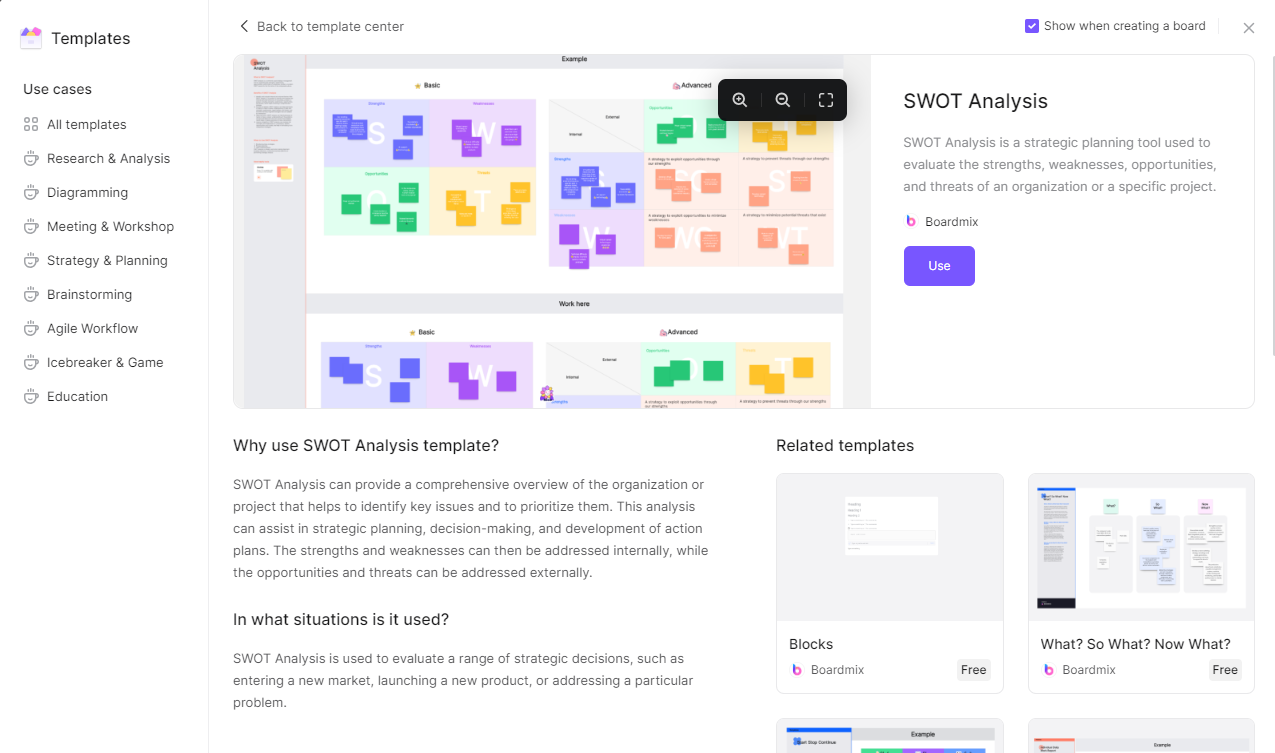
Step 4: Brainstorm and Add Notes
The next step is to start brainstorming with your team. Each team member can add notes to each section based on their thoughts and perspectives. Remember, the more diverse opinions you gather, the more comprehensive your SWOT Analysis will be.
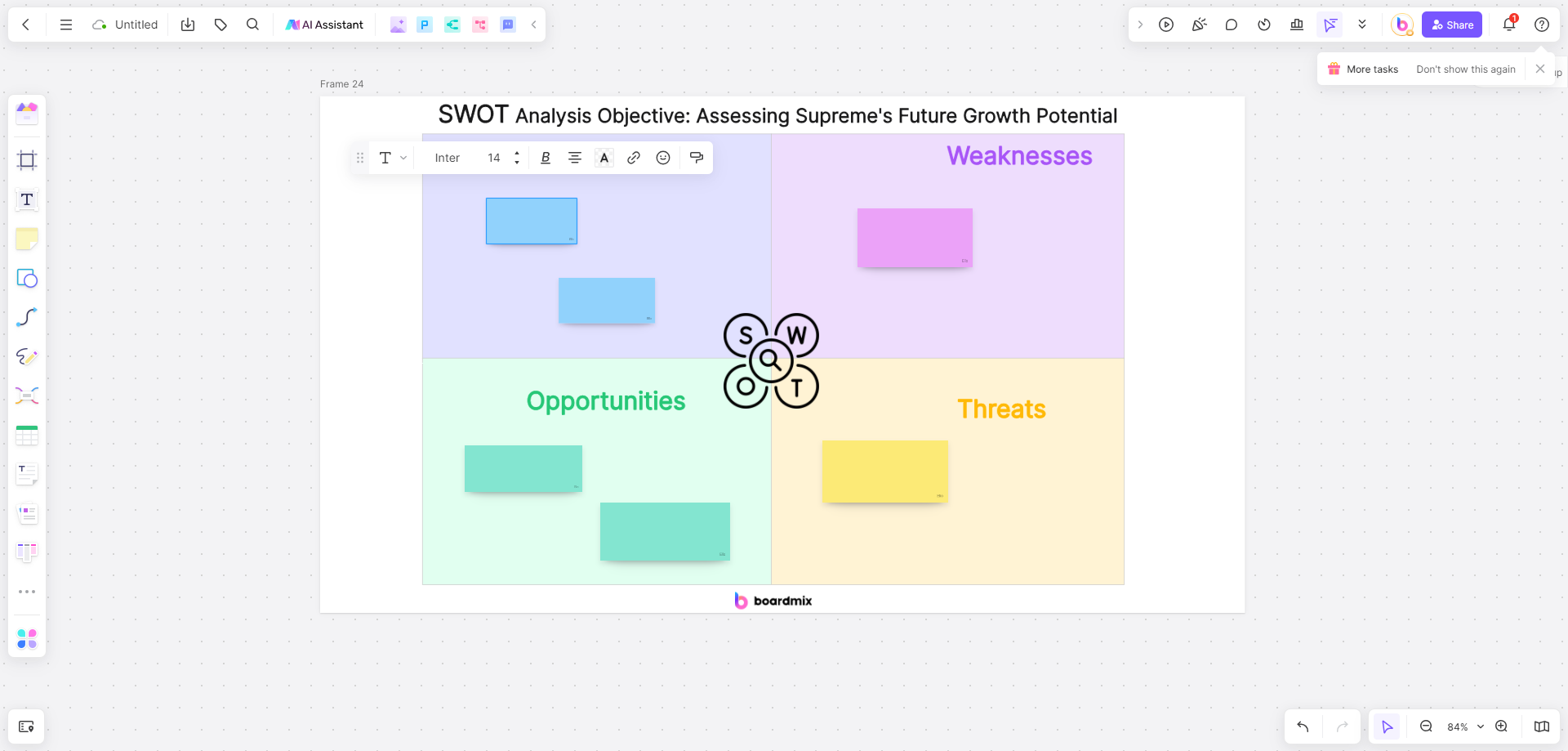
Step 5: Prioritize and Analyze
After all notes have been added, it's time to prioritize. Discuss each point with your team, moving the most critical notes to the top of each section. This process will help you identify which strengths can be leveraged, what weaknesses need to be addressed urgently, which opportunities are most beneficial, and what threats require immediate attention.

Step 6: Develop Strategies
Once you've prioritized your SWOT factors, start developing strategies. Leverage strengths and opportunities to achieve your objective and address weaknesses and mitigate threats that could impede progress towards your goal.
Step 7: Implement, Monitor, and Adjust
Finally, implement the strategies derived from the SWOT Analysis. Remember, the analysis is dynamic and should be reviewed and adjusted as internal or external circumstances change.
Boardmix provides an effective platform to conduct a thorough SWOT Analysis by facilitating collaborative brainstorming and strategic planning within a team. It ensures all voices are heard, leading to more comprehensive insights and robust strategies.
Mistakes to Sidestep in SWOT Analysis
SWOT Analysis is an effective strategic tool, but like any other method, it's prone to certain pitfalls. By sidestepping these common mistakes, you can ensure your SWOT Analysis yields the most accurate and useful results.
- Confusing Internal Factors with External Factors
It's critical to distinguish between your organization's internal factors (strengths and weaknesses) and external factors (opportunities and threats). Blurring these lines may lead to an inaccurate assessment, resulting in flawed strategic decisions.
- Overlooking Realistic Assessment
A common mistake is allowing subjective bias to influence your SWOT Analysis. Overestimating strengths or underestimating weaknesses can lead to unrealistic strategic plans. Ensure that all assertions are backed by tangible evidence to maintain objectivity.
- Overgeneralization
Avoid generalizations in your SWOT Analysis. Each point should be specific and directly related to your organization's situation. Broad statements can lead to misinterpretation and vague strategies.
- Lack of Prioritization
While it's essential to identify all strengths, weaknesses, opportunities, and threats, not all carry equal weight. Neglecting to prioritize these factors can overwhelm strategic planning and decision-making processes. Focus on the most critical issues that can substantially impact your business.
- Failure to Update SWOT Analysis
A static SWOT Analysis quickly loses relevance in today's fast-paced business environment. It's essential to revisit and update your SWOT Analysis regularly to reflect any changes in your internal operations or the external environment.
- Lack of Actionable Strategies
Merely listing the strengths, weaknesses, opportunities, and threats without developing actionable strategies renders a SWOT Analysis futile. Remember, the objective is to leverage strengths and opportunities and address weaknesses and threats.
- Not Involving All Relevant Stakeholders
The insightfulness of a SWOT Analysis hinges on the breadth of perspectives included in the process. Failure to involve all relevant stakeholders may lead to incomplete or biased analysis.
Sidestepping these common mistakes can ensure your SWOT Analysis is a powerful tool that delivers valuable insights, informing strategic planning and decision-making processes that will ultimately propel your organization toward its goals.
Real-world Examples: Successful Application of SWOT Analysis
In the world of business and strategic planning, SWOT Analysis has proven time and again to be a powerful tool. Let's delve into a real-world example where SWOT Analysis was successfully applied and resulted in effective decision-making and planning.
Case Study 1: Starbucks Corporation
Starbucks Corporation, the world's leading coffeehouse chain, has successfully used SWOT Analysis to assess its business environment and make strategic decisions. Here is a breakdown of how Starbucks implemented this powerful tool:
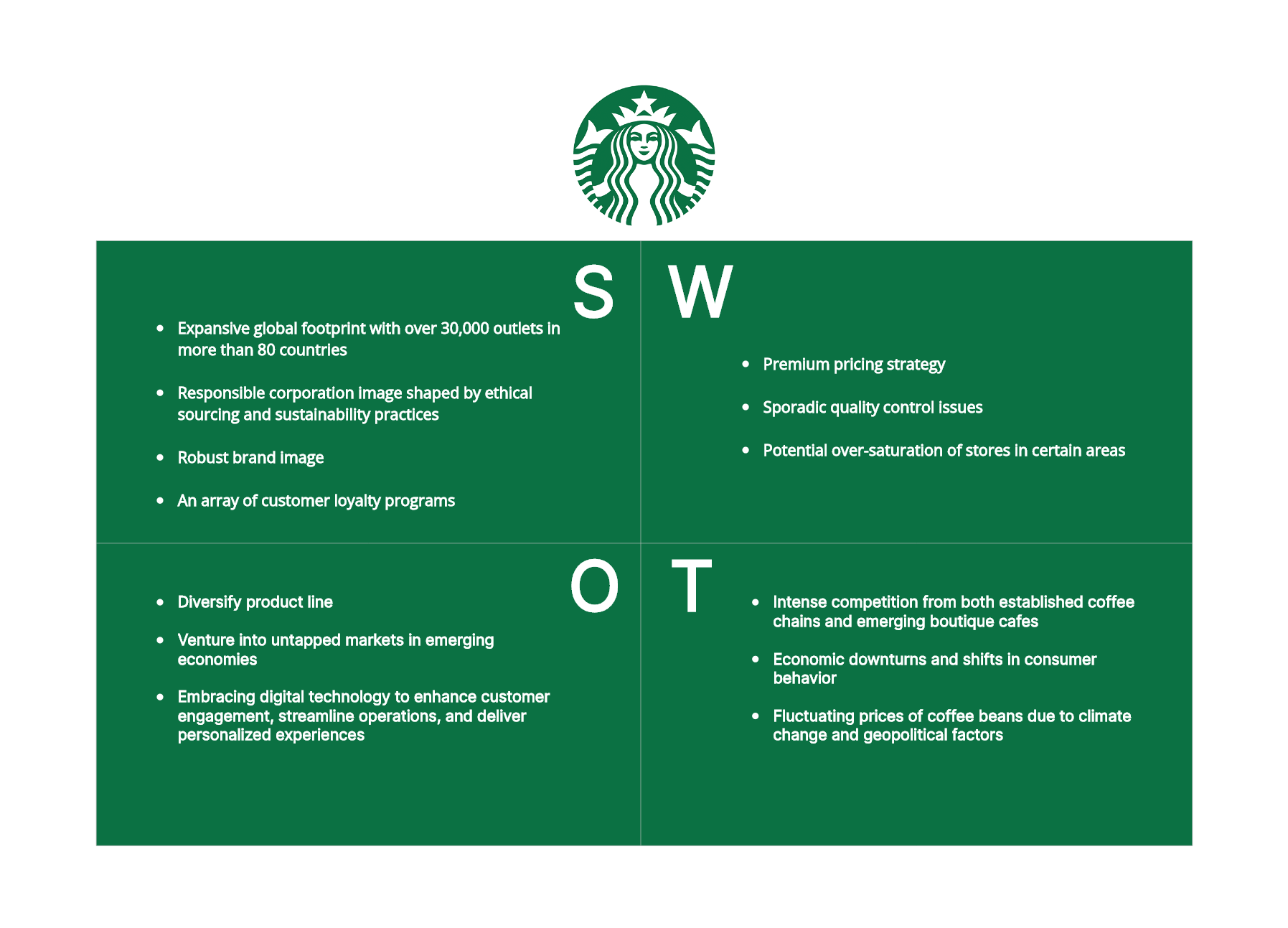
View more detailed Starbucks SWOT analysis
- Strengths: Starbucks identified its brand reputation, high-quality products, and extensive global presence as some of its significant strengths. These factors have enabled the company to maintain its market leader position in the highly competitive coffeehouse industry.
- Weaknesses: Despite its many strengths, Starbucks recognized high product prices and an extensive store network, resulting in market saturation as its main weaknesses. These weaknesses could potentially harm Starbucks by reducing its customer base and limiting expansion opportunities.
- Opportunities: Looking at opportunities, Starbucks identified expansion into emerging markets, diversification of product offerings, and enhancement of its digital operations as key growth opportunities. Tapping into these opportunities would allow the company to increase its customer base and revenues.
- Threats: Rising commodity prices, particularly coffee beans, fierce competition, and rapidly changing consumer preferences were noted as the major threats to Starbucks. These threats, if not mitigated, could significantly impact Starbucks' profitability and market position.
Using the insights gained from this SWOT Analysis, Starbucks has been able to make informed decisions, such as expanding into untapped markets, launching new product lines like tea and fresh juice, and investing in digital technology to improve customer service.
Case Study 2: Coca-Cola
Coca-Cola, the world's largest beverage company, has effectively used SWOT Analysis for strategic decision making.

View more detailed Coca-Cola SWOT analysis
- Strengths: Coca-Cola identified its powerful global brand, vast distribution network, and diversified product portfolio as crucial strengths. These strengths have contributed significantly to Coca-Cola's market dominance in the global beverage industry.
- Weaknesses: Despite its notable strengths, Coca-Cola acknowledged that its heavy dependence on the carbonated drinks segment and adverse publicity regarding health issues associated with these drinks were key weaknesses. Addressing these weaknesses was imperative to maintain its market position.
- Opportunities: Coca-Cola pinpointed the rising demand for healthy beverages, expansion into emerging markets, and enhancement of customer engagement through digital marketing as significant opportunities. Pursuing these opportunities could further bolster Coca-Cola's market presence and revenue streams.
- Threats: Coca-Cola identified intense competition, changing consumer preferences towards healthier drinks, and fluctuations in foreign currency exchange rates as potential threats. Timely mitigation of these threats is vital to sustain Coca-Cola's market leadership.
Leveraging the insights derived from the SWOT Analysis, Coca-Cola introduced healthier beverage options, expanded its operations into emerging markets like Africa and Asia, and invested in innovative marketing campaigns to improve brand loyalty.
Case Study 3: McDonald's
McDonald's, one of the world's leading fast-food chains, has also successfully applied SWOT Analysis to guide its strategic planning.
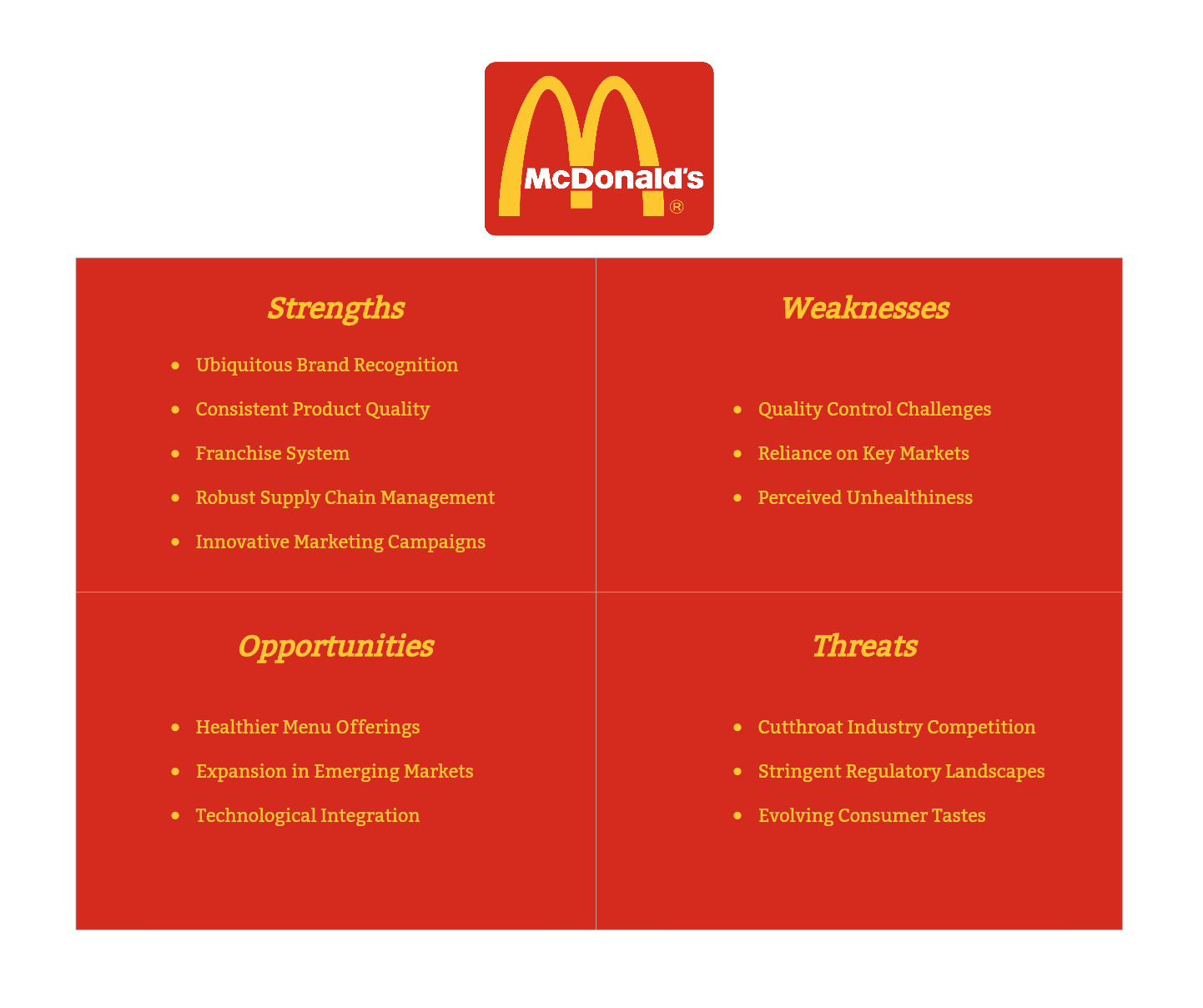
View more detailed McDonald’s SWOT analysis
- Strengths: McDonald's recognized its powerful brand image, large scale of operations, and innovative product offerings as primary strengths that underpin its leadership in the fast-food industry.
- Weaknesses: However, McDonald's acknowledged criticisms related to health issues associated with fast food and the uniformity of products across different markets as significant weaknesses. Addressing these weaknesses is necessary to sustain customer loyalty and market growth.
- Opportunities: McDonald's saw opportunities in the increasing demand for healthier food options, expansion into untapped markets, and enhancement of its digital ordering system. Capitalizing on these opportunities would allow McDonald's to further broaden its customer base and boost revenues.
- Threats: Intense competition, changing consumer preferences towards healthier meals, and potential supply chain disruptions were seen as threats by McDonald's. Proactively managing these threats is essential to maintain McDonald's competitiveness.
Using SWOT Analysis insights, McDonald's introduced healthier menu options, entered new markets such as Vietnam and Kazakhstan, and upgraded its digital ordering platform for improved customer service.
The successful application of SWOT Analysis by these famous brands illustrates how this strategic tool can offer valuable insights into a company's internal strengths and weaknesses and external opportunities and threats, thus informing effective decision making and strategic planning.








